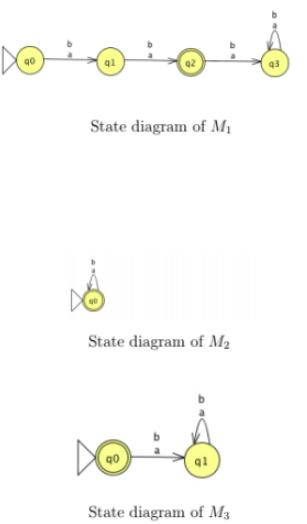Question
Consider the following sets representing computational problems (a) For the DFA M 1 with the given state diagram, list all and only P i such
Consider the following sets representing computational problems

(a) For the DFA M 1 with the given state diagram, list all and only P i such that (M 1 ) ∈ P i (where 1 ≤ i ≤ 6)

(b) For the DFA M 2 with the given state diagram, list all and only P i such that (M 2 ) ∈ P i (where 1 ≤ i ≤ 6)
(c) For the DFA M 3 with the given state diagram, list all and only P i such that (M 3 ) ∈ P i (where 1 ≤ i ≤ 6)
(d) Which one of the following statements is true?
i. P 5 ⊆ P 6
ii. P 6 ⊆ P 5
iii. EQ DFA ⊆ P 6
iv. P 6 ⊆ EQ DFA
P = {(M) | M is a DFA over (a, b} and L(M) # 0} P = {(M)| M is a DFA over {a, b} and |L(M)| = 1} P= {(M) | M is a DFA over {a, b} and L(M) is finite} P = {(M) | M is a DFA over (a, b} and ab e L(M)} P, = {(M, M") | M and M' are both DFA over {a, b} and L(M) # L(M")} P = {(M, M") | M and M' are both DFA over {a, b} and L(M)C L(M')}
Step by Step Solution
3.44 Rating (160 Votes )
There are 3 Steps involved in it
Step: 1
a M 1 has only one state q 2 Only four strings result in this final state so LM 1 aa ab ba bb So LM ...
Get Instant Access to Expert-Tailored Solutions
See step-by-step solutions with expert insights and AI powered tools for academic success
Step: 2

Step: 3

Ace Your Homework with AI
Get the answers you need in no time with our AI-driven, step-by-step assistance
Get Started


